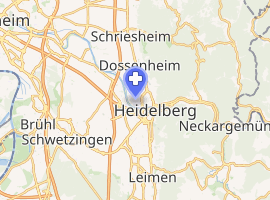University Hospital Heidelberg
The university hospital of Heidelberg is one of the largest[1] medical centers in the Federal Republic of Germany behind the Charité in Berlin and the LMU Klinikum in Munich. It is closely linked to Heidelberg University Medical School (Heidelberg University Faculty of Medicine) which was founded in 1388 and is thus the oldest within the Federal Republic of Germany.
| University Hospital Heidelberg | |
|---|---|

| |
| Geography | |
| Location | Neuenheimer Feld, Bergheim, Germany |
| Organisation | |
| Type | Teaching |
| Affiliated university | Universität Heidelberg |
| Services | |
| Beds | 1,900 (2012) |
| History | |
| Opened | 1388 |
| Links | |
| Website | www.klinikum.uni-heidelberg.de |
The university hospital is actually made up of 12 hospitals, most of them being situated on the New Campus (University of Heidelberg), about 10 driving minutes away from the old town.
Patient care
Per year about 700,000 patients are treated at the University Hospital Heidelberg. The Hospital is especially renowned for the treatment of cancer. A recent innovation in the care of cancer patient is the foundation of the National Center of Tumor Diseases (NCT) in cooperation with German Cancer Research Center (DKFZ). The goal of NCT is an interdisciplinary collaboration between various clinical and basic science disciplines and the fast implementation of new and innovative therapeutic procedures. A good example for the Heidelberg's leading position in innovative cancer research and treatment is HIT (heavy ion therapy). HIT utilises scanned beams of heavy ions, like carbon ions, and is thought to be superior in the treatment of some cancers compared to normal photon radiation. The new facility at University Hospital Heidelberg is unique in the world. The HIT radiation beam is directed by a 600 metric ton gantry which is rotated to focus the beam. Despite this enormous mass the deviation of the beam is less than ½ millimeter. In order to achieve this accuracy the whole gantry has to be maintained at a constant temperature. The total cost of the facility amounted to more than 100 Million Euros (2009).
Research
Close ties exist between it, the University Hospital and different research institutions in Heidelberg, e.g. German Cancer Research Center, Max Planck Institute for Medical Research and European Molecular Biology Laboratory.
Medical education
Heidelberg University medical degree program, two years of basic science, followed by the first of the two steps of the German medical licensing examination, and four years of clinical studies, has undergone a fundamental reform in 2001: From 2001 on, all medical students at Heidelberg University, University Hospital Heidelberg (as opposed to the Heidelberg University Faculty of Medicine in Mannheim) pursue a reformed six-year-long course named "HeiCuMed" ("Heidelberger Curriculum Medicinale"). This degree course is an adapted version of the Harvard Medical School curriculum. Undergraduate, graduate and postgraduate programs of Heidelberg University Medical School have played a fundamental role in Heidelberg being awarded "University of Excellence" status by the German Universities Excellence Initiative.
University Hospital Clinics
Most of the University Hospital Clinics are located on the Science and Medicine Campus Im Neuenheimer Feld, while some Clinics remain across the River Neckar in the Altklinikum Bergheim. In total there are 15 University Hospital Clinics:
- Centre for Internal Medicine (Krehl-Klinik, named after Ludolf von Krehl)
- Surgical Clinic
- University Clinic for Anaesthesiology
- Women's'Clinic
- Centre for Children's and Pediatric Medicine
- Centre for Psychosocial Medicine
- Maxillo-Dental Clinic
- Eye Clinic
- Ear, Nose and Throat Clinic
- Neurological Clinic
- Neurosurgery Clinic
- Dermatology Clinic
- Radiology Clinic
- Centre for Orthopaedic, Unfallchirurgie und Paraplegiologie (Located in Heidelberg-Schlierbach)
- Thoracic Clinic (Located in Heidelberg-Rohrbach)
In addition – though legally not belonging to the University Hospital Heidelberg – the following act as clinics of the University Hospital of Heidelberg:
- Clinic for Workplace-accidents in Ludwigshafen,
- Clinic for Plastic and Hand-surgery of the University of Heidelberg
There are several institutes belonging to the University Hospital Heidelberg that carry out further diagnostics and research:
- Institute for Human Genetics
- Institute for Immunology
- Centre for Infectious Diseases
- Institute for Medical Computer Science and Biometry
- Institute and Polyclinic for Work- and Social-medicine
- Institute of Pathology
- Institute for Legal medicine and traffic medicine
- Institute for Public Health
Four institutes are administered by the University Hospital Heidelberg:
- Institute for Anatomy and Cell Biology
- Institute for Physiology and Pathophysiology
- Institute for the History and Ethics of Medicine
- Pharmacology Institute
Notable researchers and physicians affiliated with the Research Cluster Heidelberg in recent time
- Markus Büchler, surgeon, professor of medicine at Heidelberg University, renowned for pioneering works in surgery of pancreas,
- Hugo Katus, cardiologist, professor of medicine at Heidelberg University, developed the Troponin T test (biochemical detection of a myocardial infarction),
- Bert Sakmann (Nobel Prize in Physiology or Medicine, 1997), professor at Heidelberg University and an Emeritus Scientific Member of the Max Planck Institute for Medical Research in Heidelberg,
- Harald zur Hausen (Nobel Prize in Physiology or Medicine, 2008), from 1983 until 2003 served as a chairman and member of the scientific advisory board of the German Cancer Research Center in Heidelberg and professor of medicine at Heidelberg University.
History of the hospital
- 1386: Foundation of the Universität Heidelberg by Elector Palatine Ruprecht I.
- 1388: Heidelberg School of Medicine commences education
- 1868: Foundation of the Heidelberg University Eye Hospital
- 1899: For the first time women are allowed to study Medicine in Heidelberg
References
- "Die Top 25 der größten Unikliniken in Deutschland: Hier gibts die Liste". praktischArzt: Die Stellenbörse für Ärzte und Medizinstudenten (in German). 2016-11-24. Retrieved 2017-01-12.